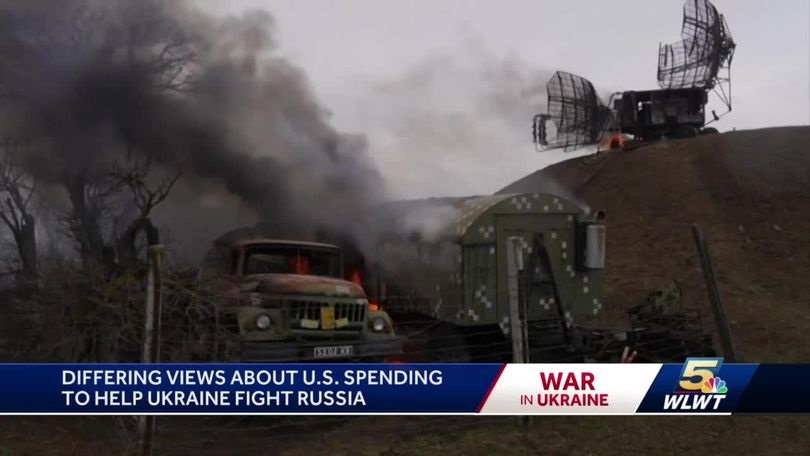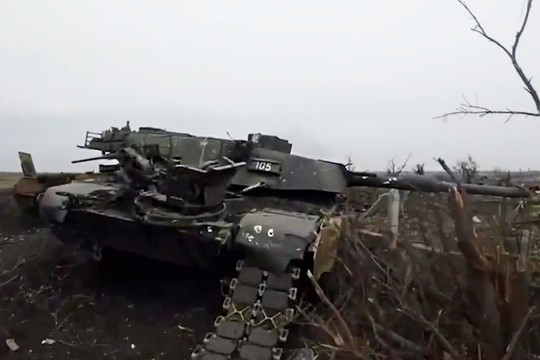Another Abrams has gone…
Ukraine has sidelined U.S.-provided Abrams M1A1 battle tanks for now in its fight against Russia, in part because Russian drone warfare has made it too difficult for them to operate without detection or coming under attack, two U.S. military officials told The Associated Press.
The U.S. agreed to send 31 Abrams to Ukraine in January 2023 after an aggressive monthslong campaign by Kyiv arguing that the tanks, which cost about $10 million apiece, were vital to its ability to breach Russian lines.
But the battlefield has changed substantially since then, notably by the ubiquitous use of Russian surveillance drones and hunter-killer drones. Those weapons have made it more difficult for Ukraine to protect the tanks when they are quickly detected and hunted by Russian drones or rounds.
Five of the 31 tanks have already been lost to Russian attacks.
The proliferation of drones on the Ukrainian battlefield means “there isn’t open ground that you can just drive across without fear of detection,” a senior defense official told reporters.
For now, the tanks have been moved from the front lines, and the U.S. will work with the Ukrainians to reset tactics, said Joint Chiefs of Staff Vice Chairman Adm. Christopher Grady and a third defense official who confirmed the move on the condition of anonymity.
“When you think about the way the fight has evolved, massed armor in an environment where unmanned aerial systems are ubiquitous can be at risk,” Grady told the AP in an interview this week, adding that tanks are still important.
During its recent withdrawal from Avdeevka, a city in eastern Ukraine that was the focus of intense fighting for months, several tanks were lost to Russian attacks, the official said.

The situation in and around Ocheretyne is desperate for Ukraine, FORBS writes.
This weekend, Russian drones and scouts surveilling the front line just west of the ruins of Avdiivka, in eastern Ukraine’s Donetsk Oblast, observed something strange. Ukrainian trenches just east of the village of Ocheretyne, previously manned by soldiers from the Ukrainian army’s elite 47th Mechanized Brigade, were empty.
Seizing the opportunity, the Russian army’s 30th Motor Rifle Brigade raced several miles along the railroad threading west from Avdiivka and captured most of Ocheretyne — and potentially also Novobakhmutivka, the village south of Ocheretyne.
It’s the fastest penetration into Ukrainian territory by Russian forces in months — and it threatens to collapse Ukraine’s defensive line west of Avdiivka. A line that has held for months, but now has a deep and widening gap in it. “Pandora's box is open,” Ukrainian analysis group Deep State commented.
To get a sense of how frightened Ukrainian commanders are right now, consider the brigade they rushed into the breach north and west of Ocheretyne: the 100th Mechanized Brigade. The brigade is one of the newest and most lightly-equipped brigades in the Ukrainian army — and seemingly unsuited for the kind of front-line triage commanders are asking of it.
According to Mykola Melnyk, the 47th Mechanized Brigade company commander, “certain units just fucked off.”
The 115th Mechanized Brigade’s failure to hold the line practically invited the Russian 30th Motor Rifle Brigade into Ocheretyne — and triggered a panicky response in Ukrainian headquarters.
It’s unclear what might happen next in and around Ocheretyne.
The Russians, for their part, are keeping an entire tank division, the 90th, in reserve around Avdiivka.
If the 90th Tank Division rolls into Ocheretyne before the Ukrainian eastern command mobilizes additional reinforcements, the Russian penetration could widen into a full-fledged breakthrough — one that could force tens of thousands of Ukrainian troops to retreat west to their next line of defenses.

Despite the time and political capital spent on the $60 billion aid for Ukraine, some Biden administration officials are skeptical it’s enough for Ukraine to win its two-year war with Russia.
Battlefield dynamics have shifted a lot in the last few months, partly because Ukraine ran low on weaponry and ammunition, notes POLITICO.
Russia maintains a manpower and weapons advantage, and it would take a lot to reverse months and years of territorial losses. U.S. officials also ask questions about Ukraine’s own tactics and priorities, especially after Kyiv’s counteroffensive failed, sapping forces of materiel and morale.
On Capitol Hill, lawmakers are also expressing concerns about whether more U.S.-provided weapons can lead to a Ukrainian defeat of Russia or if it’s just enough to temporarily fend off the invasion. “That’s the question,” said a senior Democratic Senate aide.
Rep. Bill Keating (D-Mass.), who met with Zelenskyy in Kyiv this week, echoed the worries that Ukraine is going to have difficulty advancing against Russia: “There’ll be a period where I don’t think there’s going to be any major shifts.”
National Security Council spokesperson John Kirby hinted Tuesday that Ukraine still doesn’t have a fully formed plan to defeat Russia
Biden administration officials expect the $60 billion will last at least through the end of this presidential term. Should Biden win reelection against former President Donald Trump, it’s unclear if he would need to ask Congress — which could see Republicans lead both the Senate and House — for another authorization.
In the six months it took the Republican-led House to pass the Ukraine aid, senior members of Biden’s team — from CIA Director Bill Burns to Defense Secretary Lloyd Austin — asserted that Ukraine would lose the war in 2024 without additional offensive and defensive materiel from the West.
read more in our Telegram-channel https://t.me/The_International_Affairs

 11:24 27.04.2024 •
11:24 27.04.2024 •























